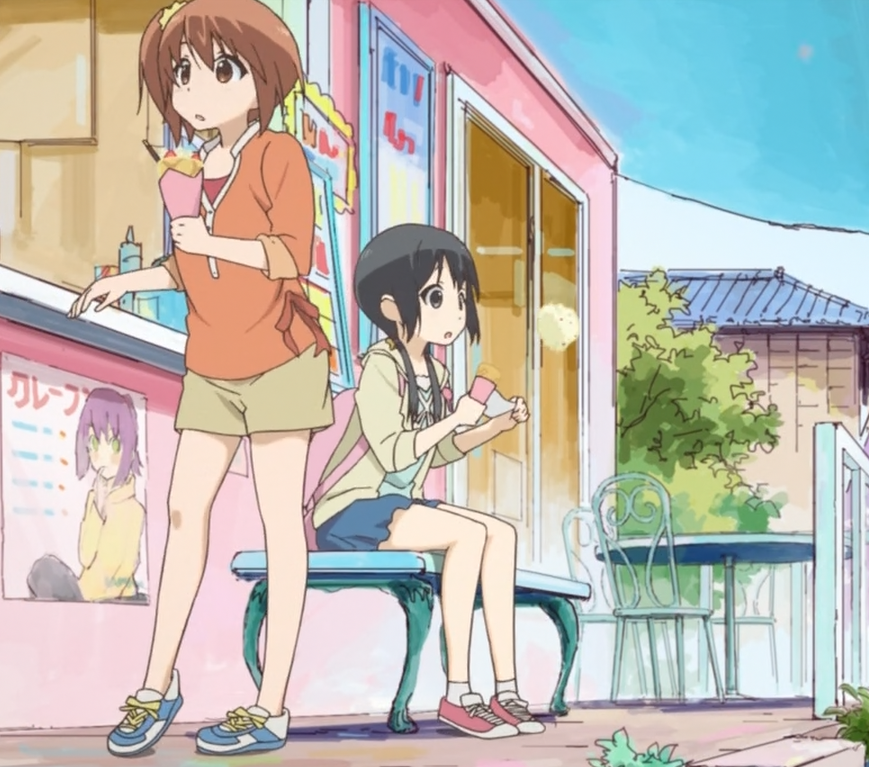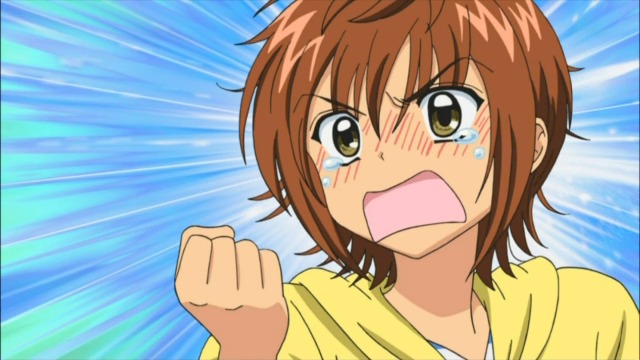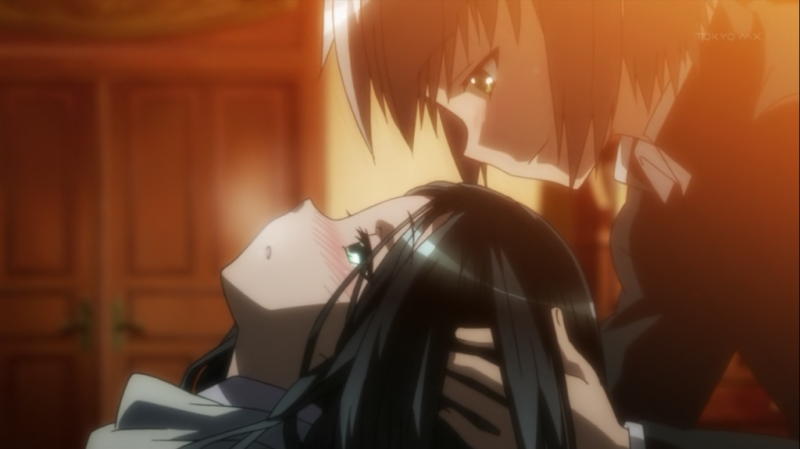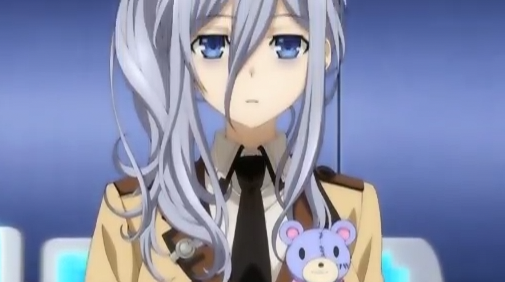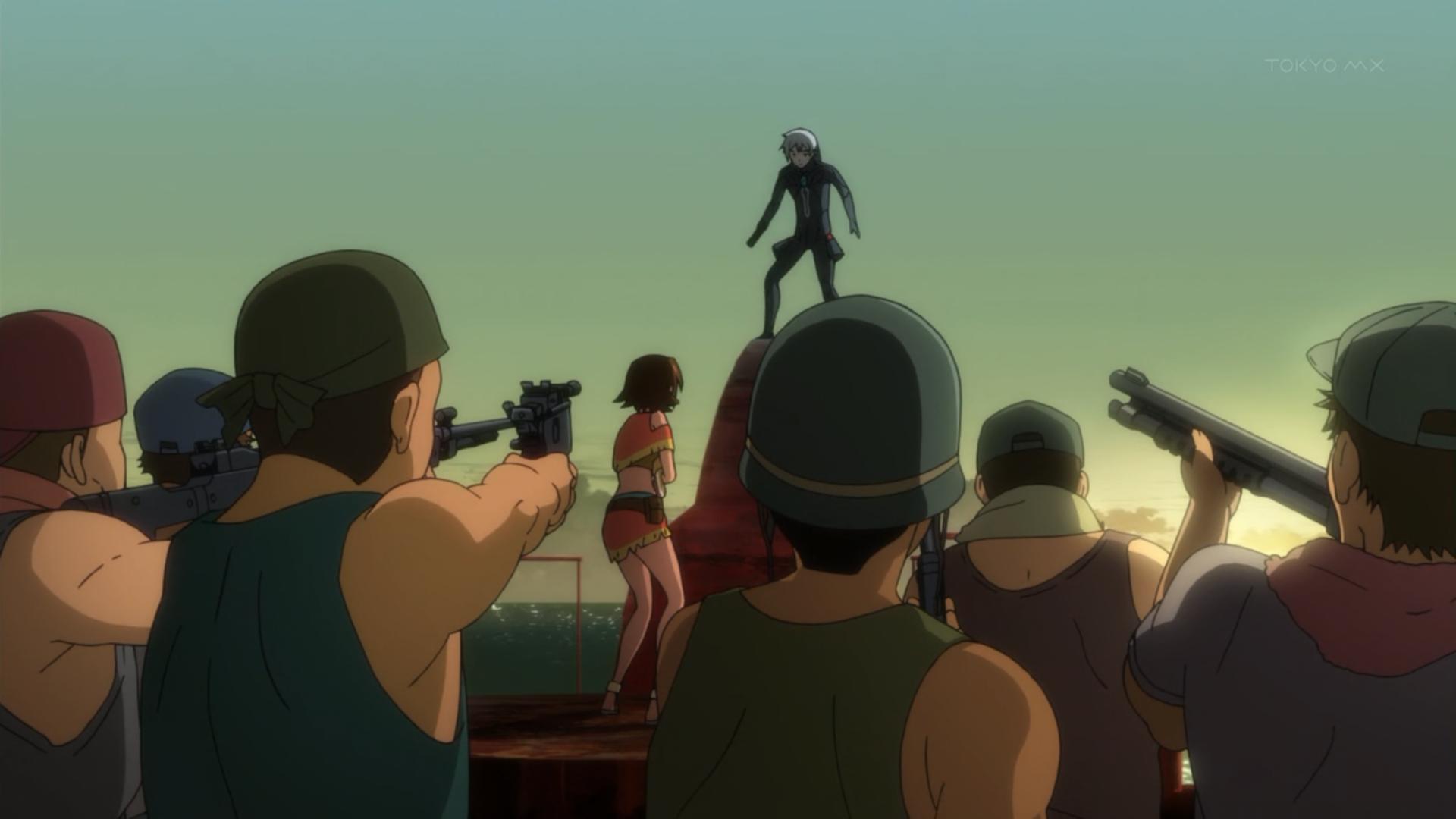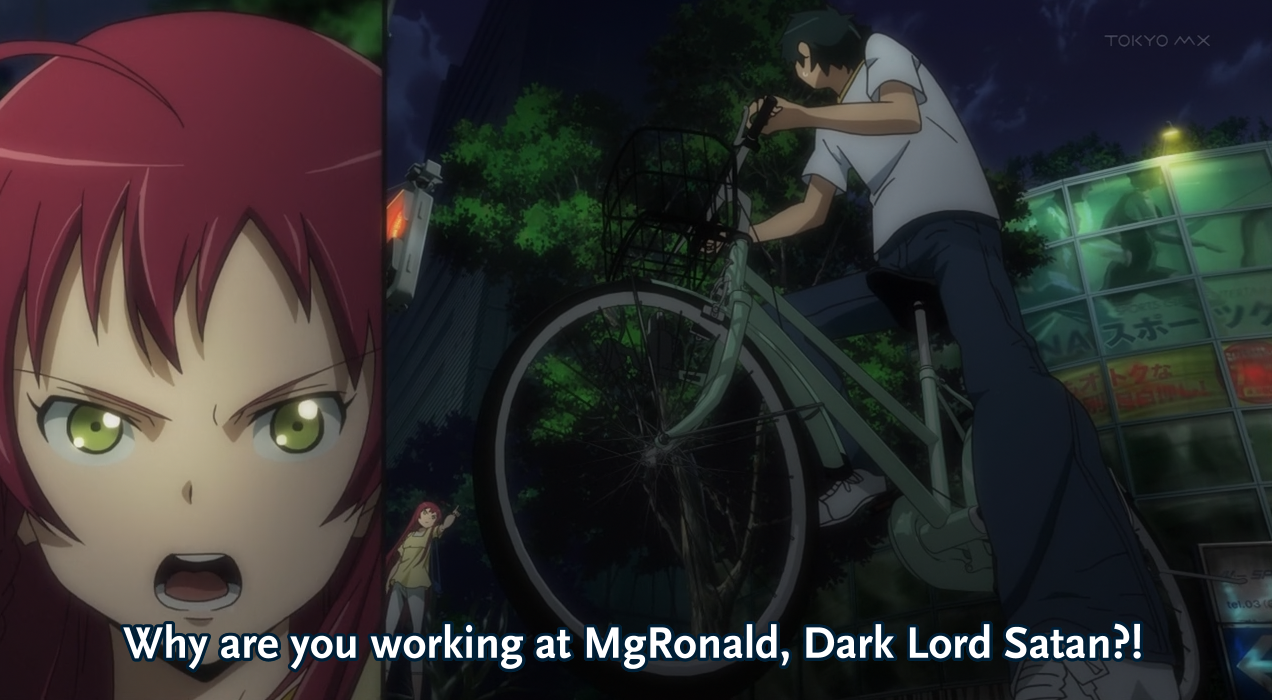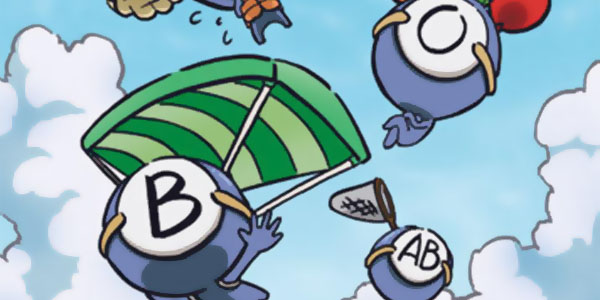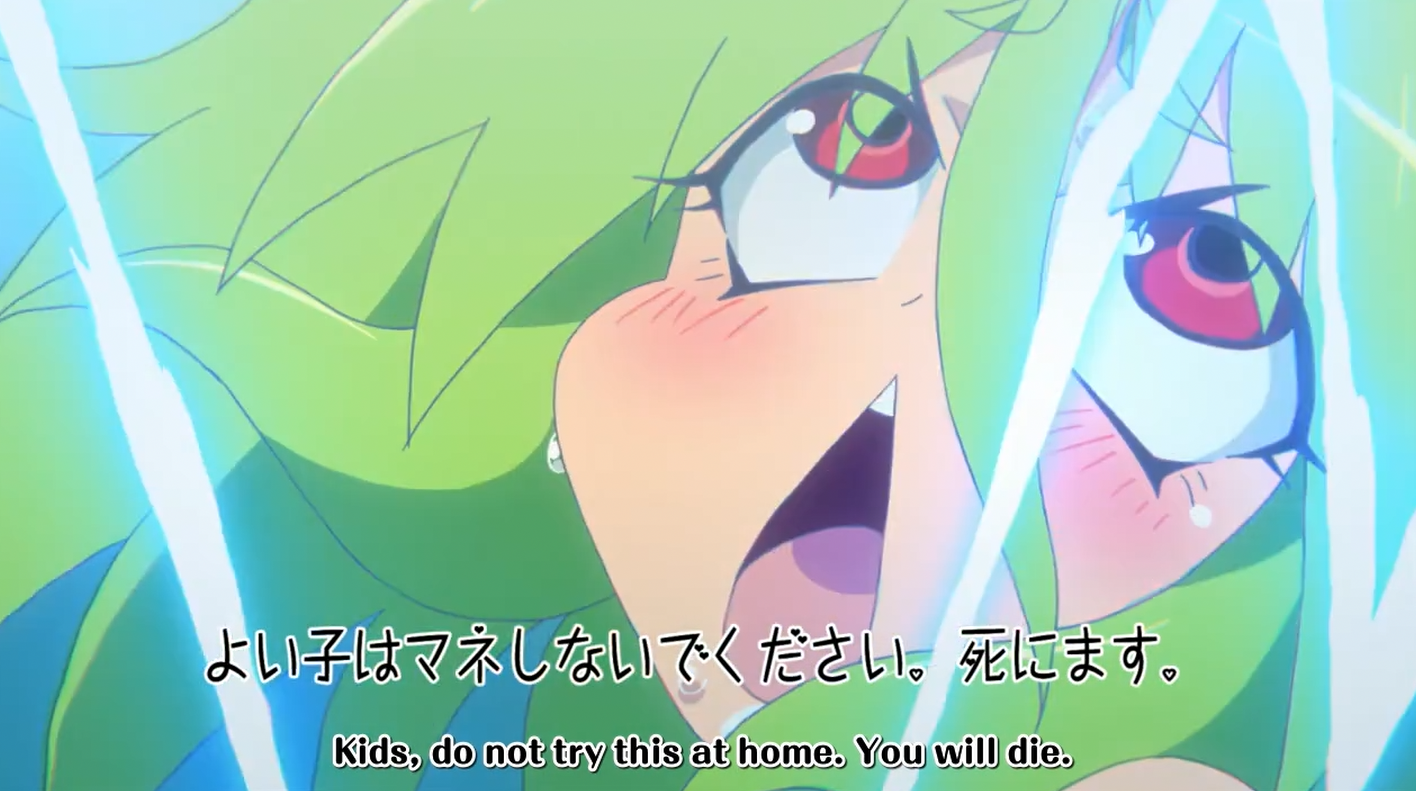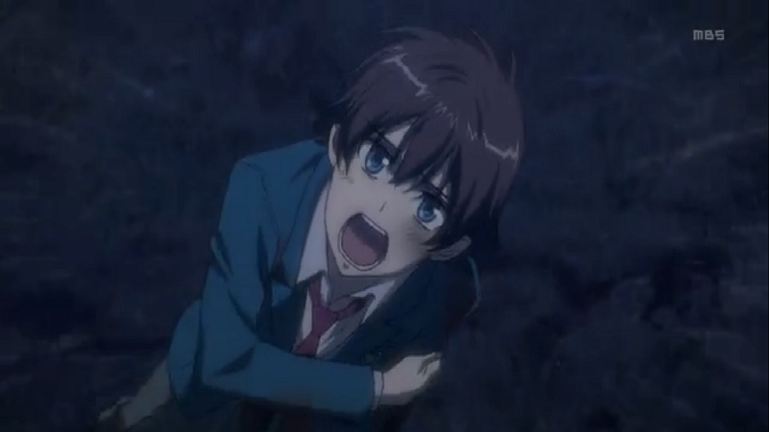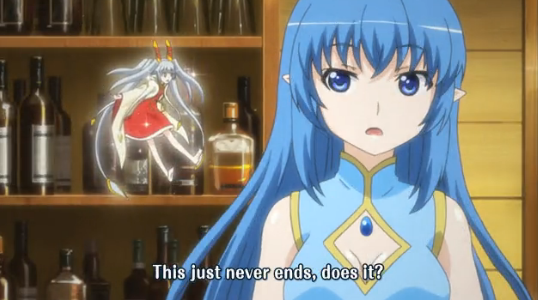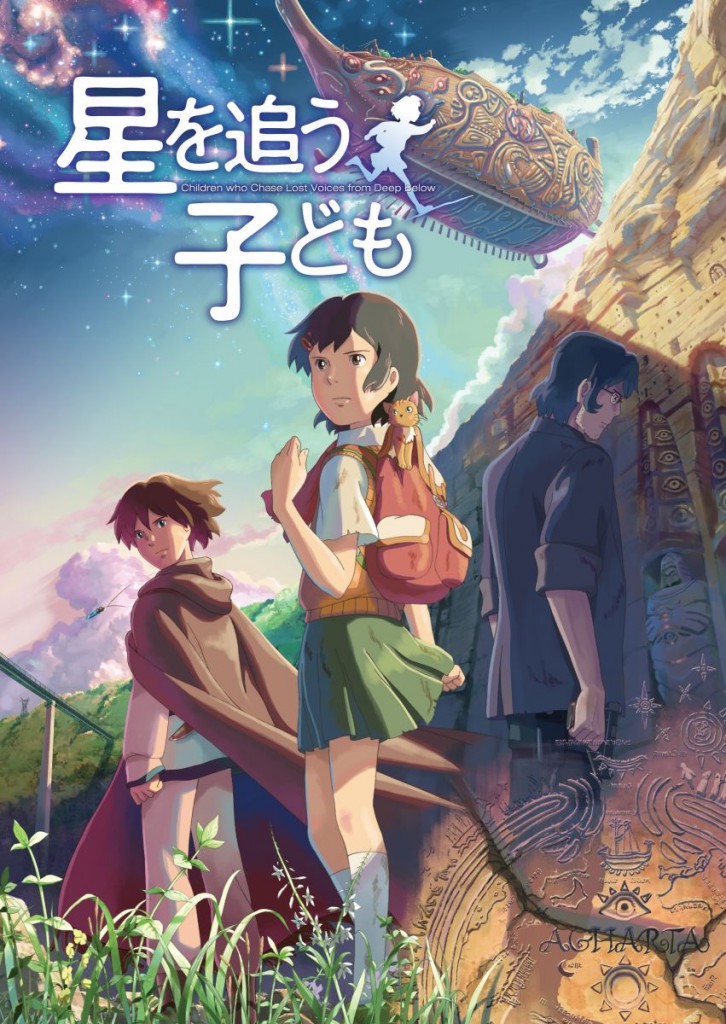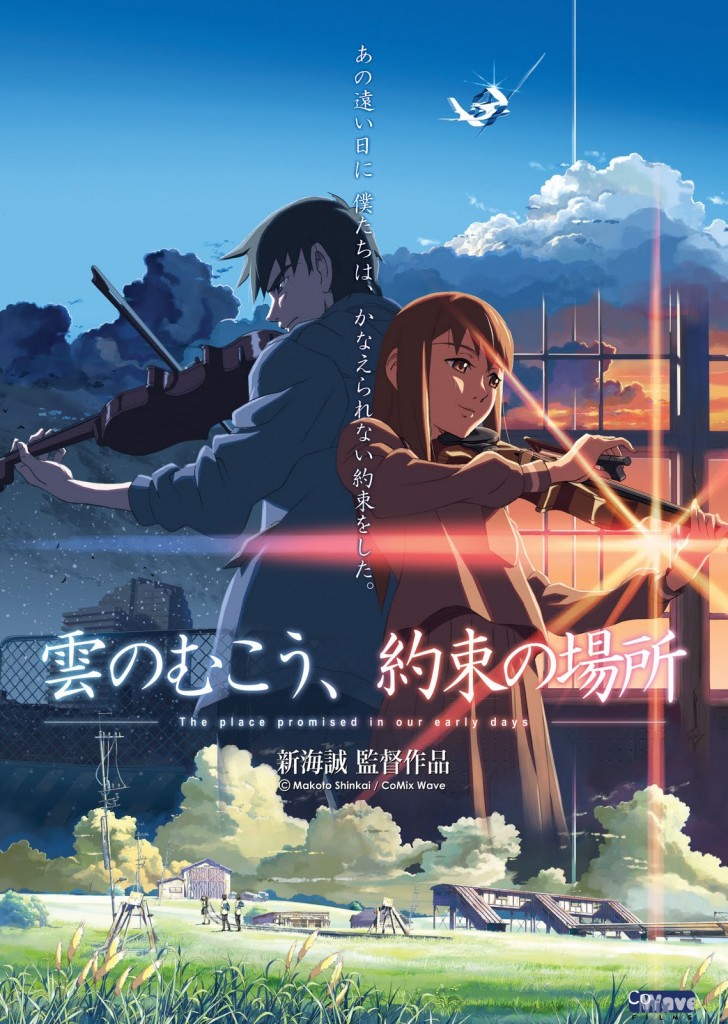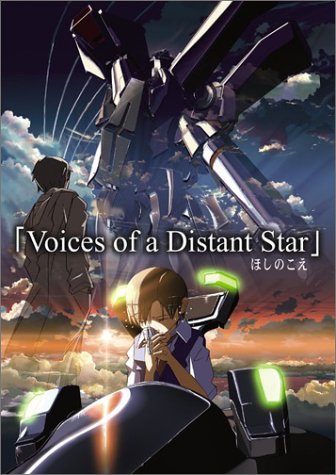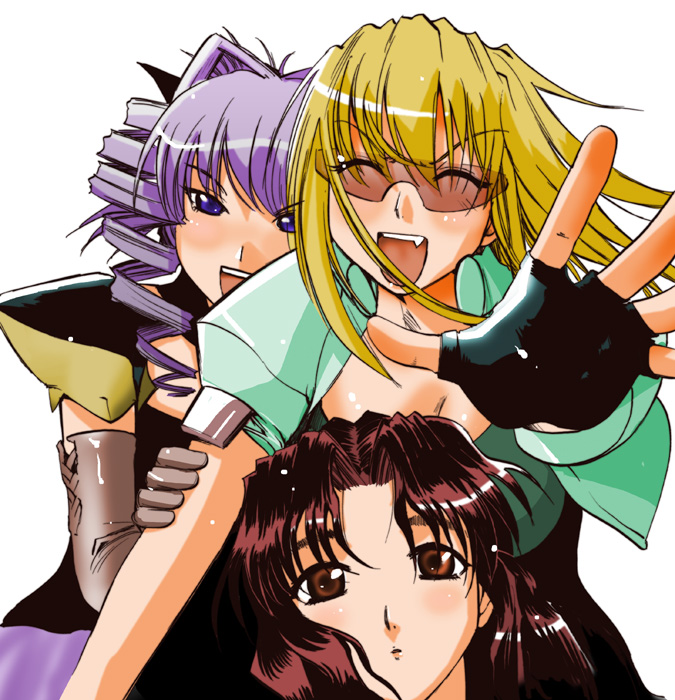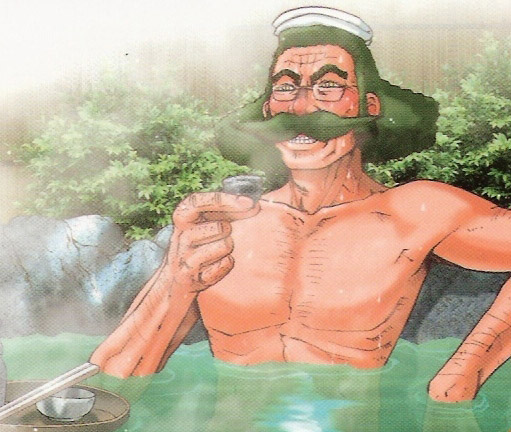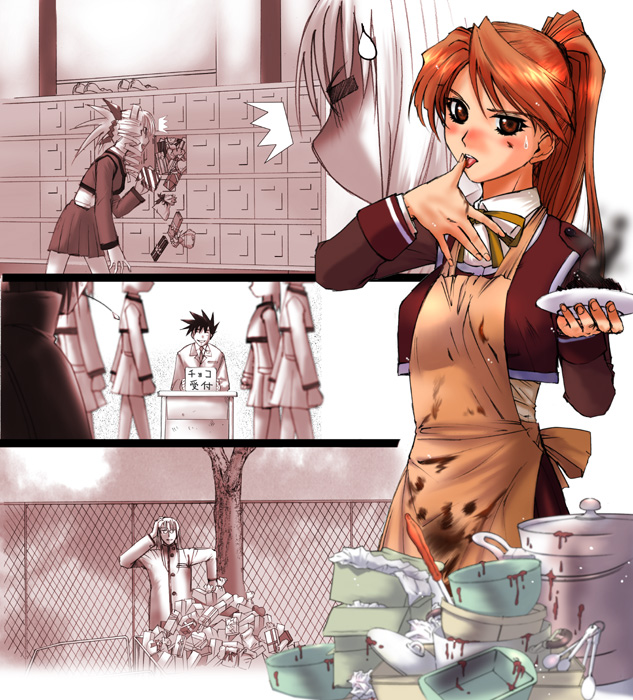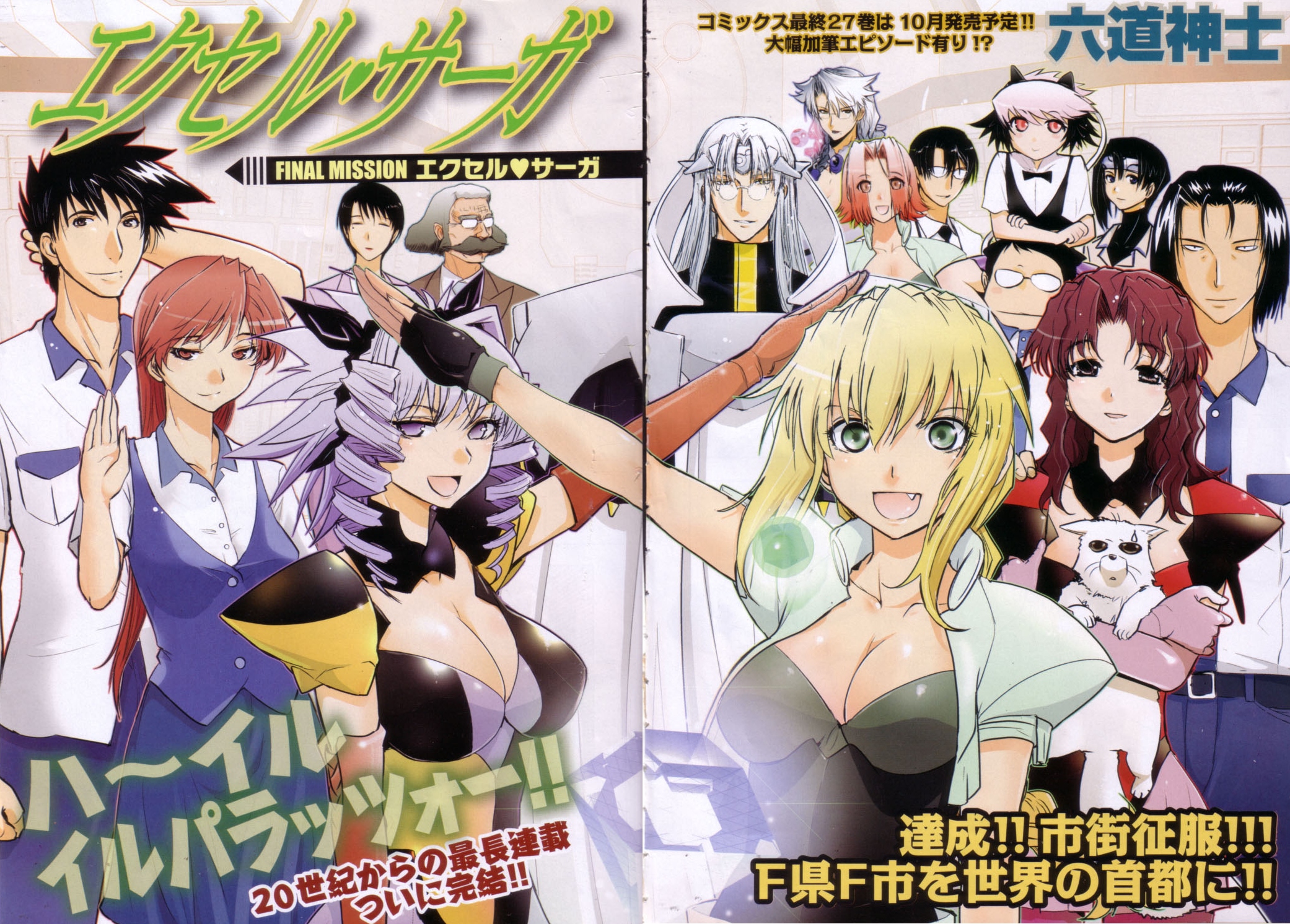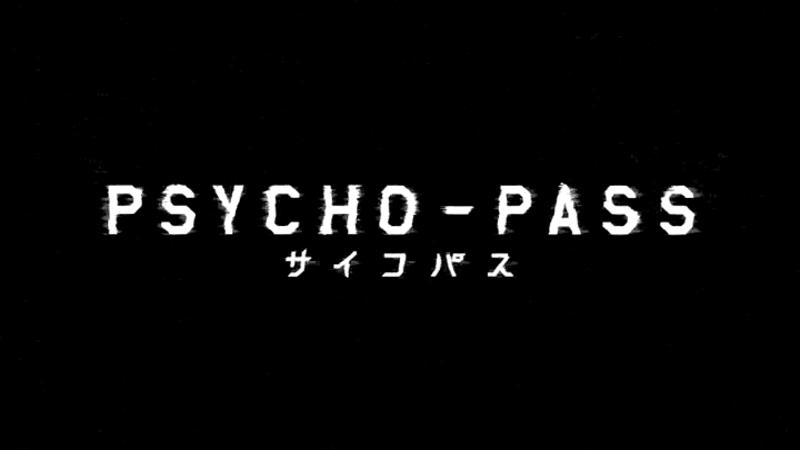04.13
Is it… can it be…? We’re on time for once!?
Aiura
Well, that was an anime.
Clocking in at exactly four minutes, Aiura spends about half of its first installment on the OP and ED, leaving only a little more than two minutes for the actual meat of the episode. This isn’t to say it was bad – in fact, it’s actually one of the lovelier looking TV anime in recent memory – but really, there’s almost nothing here. There are maybe three jokes in the entire episode, only one of which even approaching funny. The characters didn’t do enough for me to form an opinion on them. And as with all slice of life comedies, there isn’t much of a plot. It sure is pretty, though – the backgrounds especially.
I recommend checking out this first episode just for the OP. It’s delightfully insane and a lot of fun even on its own. I think that well-animated craziness alone is probably worth a 6/10. – Foggle
Aku no Hana
In a rotoscopist’s wet dream, we meet an introspective boy named Takao Kasuga, and how his love for Charles Baudelaire makes him steal a girl’s gym clothes while a vocaloid recites a poem. Somewhere in a trailer park, Miranda July is bleeding with envy.
Alright, it’s one of those anime. While this show’s a pleasant relief from whatever moe madness my cohorts are suffering from, there’s also the sense of not having anything to say. The matter’s not just because of the episode’s oddities such as voyeur camera angles and long montages of scenery, but due to how nothing really happens besides Kasuga acting like Japanese Michael Cera for extremely long stretches of time. I applaud the show for going to a different direction, especially since the source material does not have anything resembling photorealistic art, but one has to wonder if going into this style adds anything to the work. Indeed, the work is reminiscent of Tatami Galaxy, in how there’s a ton of avant-garde animation that doesn’t seem to signify anything. Not to be rude, but it just feels like the rotoscope’s just there for the sake of rotoscope. Maybe the director’s trying to make a statement against regular anime tropes or something, but his stance seems questionable when what he wants in place of the norm is something with the animation quality of an average GONZO piece. There’s only so many ham-fisted references to Les Fleurs du mal before an allusion turns into sheer pretentiousness.
And yet, I can’t say I dislike this show. The rotoscoping goes hand-in-hand with the eventual plot reveal to illustrate an extreme sense of unease. What other shows would use for pseudocomedic hijinks gets utilized as surreal horror for Aku no Hana. While the rest of the premiere felt like any twentysomething’s personal quirky indie movie, the last few minutes promise something much more haunting than what was expected. Though at the pace the episode was going, I doubt much will actually pay off.
Rating: 6/10 – Bloody Marquis
Second Opinion!
OH MY GOD THIS IS LIKE THE BESTEST ANIME EVERRR ROTOSCOPING IS SOMETHING I’VE NEVER SEEN BEFORE AND IT’S SO COOL FUCK MOE MODERN ANIME SUCKS BUT THIS SHOW IS AWESOME BEST CHINESE CARTOON I HAVE EVER SEEN IN MY LIFE THE DIRECTING AND CINEMATOGRAPHY ARE MASTERFUL IT’S BETTER THAN COWBOY BEPOP 11/10 – Foggle
Arata Kangatari
HEY KIDS! YUU WATASE’S BACK! AND SHE MADE ANOTHER SEASON OF FUSHIGI YUUGI! EXCEPT IT’S A SHONEN!….wait what? Yes Arata Kangatari is another journey into some alternate universe inspired by Chinese mythology with the difference of it being a ripoff of Freaky Friday instead of The NeverEnding Story this time around (dammit Watase, stop ripping off western movies for your mangas!)
In Universe A: everybody hates Miya-er… Arata Hinohara, a bishie with a persecution complex so deep you might as well call him Rimmer. He’s feeling so glum that he’s about reenact the opening of the Escaflowne movie because… well… that’s what depressed track teamers do. In Universe B: Lord Arata is a young lad who has the sad distinction of being a “girl” for reasons of not getting killed by armed guards. He’s been chosen as a candidate to replace the princess of this land which makes it a bit less awkward for him when said princess is killed by a bunch of her advisors and he gets framed for it, oops. Through some strange magic involving a spooky forest, the two Aratas find themselves swapping bodies, and thus wacky hijinx ensue.
Aside from the sheer 90s-ness of the setup, the show just has feels tired and stiff. Coming off of watching Gargantia and Attack on Titan, AK’s animation by comparison lacks fluidity and emotion (and this show is from the Macross Frontier studio mind you). The acting isn’t much better considering its cast of anime vets. All in all a middling entry. 5/10 – Lord Dalek
Attack On Titan (Shingeki no Kyojin)
Titans are creepy bastards, aren’t they? Between the lack of skin and those disturbing, unfaltering smiles, their designs are deliciously terrifying. But are they truly bad creatures? Maybe they’re just misunderstood, all cute ‘n cuddly under that grotesque exterior. Then again, they eat humans like it’s going out of style, so they’re probably just dicks.
Humanity has trapped itself behind a humongous wall to keep the Titans out, but Eren, our hero, isn’t so sure this is a winning strategy. He wants to join the Recon Corps and fight back against the Titans, until he sees them return from their latest mission barely intact… then he wants to be part of it even more. He’s a headstrong kid (who I assume won’t be a kid for much longer), and his determination is admirable if not immediately likeable. His journey begins as many do: with a mountain of corpses. This show appears to be properly morbid and pulls no punches with its violence or atmosphere. An air of hopelessness is omnipresent, with many bleak moments scattered throughout the episode.
Production IG did an impeccable job with the animation and direction, particularly during the more intense moments. The middle portion of the episode has a few too many still images for my taste, but it looks cool and flows very well for the most part. I must admit, though, that I can be fairly shallow at times, and did feel somewhat spoiled by the breathtaking action of Attack On Titan’s cold open. As I am the kind of person who gets a raging hard on during Dead Leaves and Metal Gear Rising, the wonderfully fluid, over the top opening scene made me yearn for more. Of course, great action is even better when it’s supported by a well-written story and developed characters, both of which are already evident from episode one… so, you know, gimme’ the next installment already! 9/10 – Foggle
Chibi Devi!, Season 2
Mao-Chan is a baby demon. Mao-chan was accidentally dumped onto a pair of poor schlubs. Mao-Chan is adorable. Mao-chan asks all the difficult questions about life. Mao-chan wants to know why mommy and daddy aren’t married and appear to actually hate each. Mao-chan does not get the answer she needs or deserves. Confused about emotions and bodily functions she does not understand, Mao-chan becomes a nymphomaniac who engages in bestiality. Life is unfair.
*DEFIES CONVENTIONAL RATINGS*/10 – Lord Dalek
Dansai Bunri no Crime Edge
Apparently we’re going through a hair cutting fetish phase this year in Anime. Last season it was Cuticle, this time its RDG and now Crime Edge. Our story is that of a socially maladroit young lad who gets off at the wrong bus stop only to meet a girl, Iwai, with very strange hair. You see our hero, Kiri Haimura, has this thing for cutting people’s hair, and Iwai has some of the most incredible locks he’s ever seen. The problem is… it cannot be cut… by anyone or anything. And thus begins Kiri’s quest to prove he’s a good enough barber to cut Iwai’s hair. That’s a stupid premise and this show so far isn’t doing anything to…
(hits eight minute mark)
Yeah forget all that, this show quickly takes a Higurashi-esque turn into weirdsville, amping up the darkness 10x. Iwai is constantly abused by her two psychopathic “sisters” via various beatings and colonic hypodermics. Kiri seems to be a bystander to some of it but doesn’t exactly seem to know what’s going on. What he does know is he owns a very special pair of scissors that can “kill” anything… including Iwai’s living hair. Hmm….
I was actually pleasantly surprised by this show after its lukewarm intro. While it seems like its trying to do too many things at once in the first show, hopefully the creative team knows what they want to do now and sticks with it. 8/10 – Lord Dalek
Date A Live
Oh, hi there mildly interesting science fiction plot about the Earth being ravaged by deadly “spacequakes”, I didn’t see you come in… wait, where are you going!? Why is this 14 year old girl shoving her panties in my face? And just what are you doing here, ambiguous incestual overtones? Take your friend homophobic side remarks and get the hell out. Cool, now it’s somewhat intriguing again… oh god, not a bratty loli space captain! Abandon ship, ladies and gents; all hope is lost.
So yeah, a group of supple, nubile young girl-demons are presumably causing “spacequakes”, the unfortunately-named rifts in time and space that began leaving small pieces of Earth in pseudo-ruins 30 years ago. To put an end to this madness, our hero has to date one of them for some reason (the girls, not the spacequakes). Well, that’s most certainly a storyline, isn’t it?
Absolutely nothing of merit happens in this first episode, unless you consider watching uninspired characters attempt to cobble together jokes about tickling and foot fetishism interesting. But at least this show avoids explaining the jokes, and even attempts deadpan delivery a few times, so it gets points for that at least. There’s also some halfway passable action and animation going on for a bit, but it kind of loses its impact when everything else is so mundane.
To its credit, while Date A Live’s first installment is quite bad, I wouldn’t say it’s offensively so. Sure, the characters are boring, the plot is idiotic, and the fanservice is annoying, but it actually seems like there was at least a tiny bit of genuine effort put into it. I’d rather avoid watching any more episodes if at all possible, but compared to such cynical dreck as last season’s Vividred Operation, it’s fookin’ Gankutsuou.
I think my standards might be lowering. 4/10 – Foggle
Gargantia on the Verdurous Planet (Suisei no Gargantia)
Several thousand years after an ecological disaster turned the Earth in a frozen wasteland (hey its Sailor Moon R all over again!), its survivors have scattered to the stars and find themselves engaged in a deadly space war with an unnamed alien race. Our hero, Red, is a mecha pilot whose three long years serving on the front lines has finally awarded him a four week long vacation, but an unforseen accident puts those plans on ice and catapults him to an unknown planet. Here he encounters a salvage team who wants to tear his robot apart for scrap and speaks a language he doesn’t understand (more on that later). Taking a girl named Amy hostage as leverage to figure out what the hell is going on and keep himself alive, Red is shocked to learn that this planet is in fact Earth, now covered entirely by oceans thanks to the ice melt and the survivors are clearly not prepared for what’s coming their way, both human and alien alike.
Garganita is the latest work by fan favorite Gen Urobuchi and thus carries with it the usual lofty expectations given to his work, happily it meets them so far. This show has a familiar space western kind of story (one could almost call it “Gen Urobuchi’s Waterworld”) but subverts it by placing obvious handicaps on the characters and their interactions. In most anime, the fact that all characters speak perfect Japanese is something that’s just easily dismissed as “well that’s anime”, here, on the other hand, Urobochi draws attention to that by making it clear that its the show itself is translating the dialogue into Nihongo and Red and the crew of the titualar ship are speaking gibberish languages that neither can understand (in fact its Red’s mecha’s onboard computer that serves as the only way Red can communicate at the moment).
In the technical department, the animation is just gorgeous, but do you expect anything less from Production IG? Character designer Hanaharu Naruko creates a clear divide between the rugged junk collectors and the pale hardened space warrior who has literally fallen into their laps. Clearly no expense was spared on this series and in this day of fast and cheap it really shows. Definitely one of the must watches this season. 9/10 – Lord Dalek
Second Opinion!
So, yeah, snails and flowers are fighting robots. Albino child soldiers who look suspiciously bishonen are forced into service for the sake of an actual place to live in. Armies name their underlings after Pokemon trainers. People use flying squirrels as pets. Tomokazu Sugita plays another gadget that does nothing but talk. Oh, the horror! Doesn’t a bit of this seem familiar? Well, screw you. Orson Scott Card be damned. He wrote a Hamlet fanfic that linked pedophilia with homosexuality. Also, he’s a mormon. Mormons suck.
And I guess this means Asa Butterfield will get considered as Red by all the Tumblr daydreamers.
After Gen the Butcher didn’t exactly cut up most of his characters in his previous show (Spoilers, sweetie!), he’s come back with robots. But who cares about robots? You’re all here because Gen’s the writer. If he wasn’t, most of you would have nodded at the anime’s poster and not done anything else. But name recognition, darlings! He made Madoka, and that means you have to follow every single thing he does until he breaks like Ben Elton did. Even if he writes a hardcore bara yaoi where all of the character are horrible elk-human hybrids, you’ll watch it. You’ll love it. You’ll buy body pillows of it! And if you question that fact, look at your Rider bodypillow and see if you can lie in front of his manly, yet woven gaze. Question him, and Rider won’t be such a tender lover.
…but yeah, this show was good.
Rating: 9/10 – Bloody Marquis
Ginga Kikoutai Majestic Prince
So apparently in another sci-fi mecha anime, a bunch of ragtag students are chosen by a mysterious masked man to pilot top-of-the-line giant robots for the fight against an evil race of aliens known as the Wulgaru.
…That’s pretty much what I got out of the first episode, since it was mostly a quick setup to get the story rolling. Other than that, it wasn’t TOO bad and was quite inoffensive really. It doesn’t do anything wrong, but at the same time it doesn’t do anything great, it just does. It set up a fairly well-established set of characters, each with their own robot designed to maximize their special talents, and a procedural first sortie that shows that they don’t fool around and can be good if they want to. Nothing too exceptional on any of those fronts except that I wasn’t at all annoyed, irked, or lamenting how bad it was. It just was.
This said, the boilerplatey-ness sadly translates a bit into the visual aesthetics, which also, just does. Hisashi Hirai continues to be a character designer who is damningly memorable in his averageness. The only really real difference between these designs and his previous works is it seems to be a bit less polished and sharp compared to his work in the Gundam SEED series and Fafner. With regards to mecha design, the most positive thing to say about them is that they’re varied in design. The only thing needed to solidify whether they’re good or not is to see more of them in action. Wulgaru are of a rather bland green glow, and don’t really have much of a menace to their image. They…. Function I guess, which is at best a good thing since it leaves room for growth.
The only GREAT thing I can say with confidence is the music. Toshiyuki Watanabe imbues the anime with a soundtrack that imbues both epic and whimsy depending on the scene. The music really stood out and elevated most of what is essentially an average product. ‘Tis eerily similar to how Toshihiko Sahashi’s music worked in the SEED series.
Either way, you can’t go wrong with continuing with this series, but then again you can go a lot more right by focusing on other properties. That said, a series like this that just… does for right now, it has nowhere to go but up, and hopefully it does right in that regard.
6/10 – The Juude
Haiyore! Nyaruko-san W
Oh hey, they made a second season of this. The episode I watched from the first series was funny but not too special, and this appears to be more of the same. There’s nothing particularly great about Nyaruko-san W’s season opener, but it’s got a couple of good jokes lodged in there, plus a truckload of occasionally inventive meta humor to chuckle at. It’s not fantastic comedy by any stretch of the imagination, but it’s decent enough in its own right.
Thankfully, it appears that some character development actually occurred over the course of season one. Male protagonist Yasaka, while still kind of awful, no longer made me want to rip my own teeth out ala Oldboy, and even did a few humorous things in this episode. Sadly, Nyarlko is less funny this time around (in order to balance it out, I guess), but the rest of the cast complements her well enough, so that’s forgivable. The voice acting ranges from fun and energetic to grating, thankfully leaning more toward the former, though it does dip into ear-clenching territory a couple of times. The animation, meanwhile, is only passable… which means it’s godlike by Xebec standards. Good work on this one, fellas.
I’m somewhat embarrassed to admit that this show has become a guilty pleasure of mine. I struggle to call it “good,” but it’s clever and silly enough to keep me entertained, and I’ll probably end up watching the rest of it eventually. The little details – like the way Nyarlko’s hair adjusts itself into various shapes (often somewhat subtly) – and the meta jokes – such as how the characters manage to talk to the audience without being obnoxious about it – make me smile, so yeah. I like it. I’m not gonna’ fully endorse it, but I like it. Maybe you will too…? 6.5/10 – Foggle
Hataraku Maou-sama!
Satan’s forces of evil ravage the land, murdering all who would oppose him. A hero of incomparable strength and resolve defeats him in combat, but he swears vengeance, and escapes to another universe through a magic portal. Upon arriving in this strange new land with his #1 underling, Alsiel, he discovers that the people’s customs are far different from his own, and that his magic will no longer work to full effect. Thus begins their quest to find a way out of this terrifying, upside-down world known as “modern day Japan” and back to the fantasy realm of comforting pestilence and war. Naturally, the first step on his journey back is to rent a flat and get a part-time job at McDonald’s.
I was very pleasantly surprised by this series. Going in, I knew nothing about it but the name, so I had no expectations to speak of. At first, I thought I was in for a retread of last season’s pretty-good-at-first-but-then-later-on-not-at-all Maoyuu Maou Yuusha, albeit one with far prettier visuals, but then the “twist” came and I was all like, “oh hell yeah.” The first four minutes or so actually make it look quite convincing as a fantasy action/adventure series, with awesome artwork and great animation. In spite of reverting to a more standard anime style afterward, it still continues to move very fluidly once it turns into a comedy. Little things, like the way Satan rides his bike and flips french fries, managed to bring a smile to my face due to how energetically it was animated.
You’re probably expecting some typical fish-out-of-water jokes, and indeed, Hataraku Maou-sama! has ‘em, but the presentation makes them extremely funny anyway. It’s rare that an anime actually makes me laugh, but this one certainly did, and many times at that. The quirky demon language alone – which is basically gibberish spoken in a bad French accent – is worth a chuckle or two. The comedy is almost all dialogue-based, without relying on puns, and crosses cultural boundaries with little trouble. In general, the humor works quite well and doesn’t talk down to the audience by explaining the jokes (as many anime unfortunately do).
Overall, I thought this first episode was hilarious. Satan is a very likable character and I look forward to seeing more of his misadventures next week. Highly recommended! 9/10 – Foggle
Hentai Prince and the Stony Cat
I am recording these diatribes under heavy stress, for the eldritch chaos my eyes have witnessed would irreparably scar the most noble minds of this terraqueous globe. The material life is a cruel tyranny, and none can cast further evidence than this televised concoction from the fiendish Asian landmass. A young Celestial desires to expel his impurities, only to become an orator of pure truth. The cruel reality forced upon his essence incarnates into debaucheries unseen since the eve of Sade. No fraction of opium could relive the illness of this narrative, with only the comfort of ignorance to those too blind to acknowledge such Oriental monstrosities. Any opinion contrary to one such as this must be distrusted, for they lie with the brutality of the unknown…
Rating: 1/10 – Bloody Marquis
Hyakka Ryouran: Samurai Bride
You know I originally had this huge review setup for this show explaining in detail why it is a foul steaming piece of shit, however this image posted at Kurogane’s Anime Blog pretty much did it for me in not nearly as many words.
I believe there’s a lesson there for all of us.
1/10 – Lord Dalek
Karneval
Protagonist Nai awakens from a hallucination to discover himself on the receiving end of some kinky femdom roleplay, but then the woman turns out to be some sort of terrifying demon thing, so I guess that kind of sucks. He’s saved by a man wearing goggles that are literally impossible to see out of named Gareki, and then gets involved in a trainjacking. A flying magician – complete with top hat and baton – from an organization called Circus shows up, assisted by an ass-kicking, candy-colored teenage girl. Together, our four heroes save the day.
If you haven’t guessed by now, this show is pretty damn stupid. It also takes itself 100% seriously, but sadly not in a fun, camp way like the 60’s Batman series did. It’s not unwatchable or anything like that, but the complete lack of humor contrasts poorly with the absurd storyline and diabetes-inducing ED, playing everything so straight that it somehow manages to become boring. A description of the events in this episode read like some sort of action anime parody (seriously, who thought naming the homeland security department “Circus” was a good idea?), but unless Karneval was purposefully written as extremely highbrow satire, I’m going to assume that it’s just oblivious to its own ridiculousness.
But when it’s all said and done, I didn’t totally hate this episode. The music was great, as were the few scant moments of action. I wasn’t a fan of the character designs, but outside of one particular scene – Gareki jumps off a bridge and you can practically see the wires in spite of this being a cartoon – the animation was also pretty good. It’s just a shame that everything else about it is so bloody uninteresting. 4/10 – Foggle
Ketsuekigata-kun!
As if animes about shipping and compatibility weren’t bad enough, we have a show that is literally nothing but shipping and compatibility. Bravo Japan! 2/10 – Lord Dalek
Second Opinion!
I learned a lot about blood from this show. Mostly that if a comedy anime is unfunny enough, I’ll want to slit my wrists. And then blood comes out of them. 1/10 – Foggle
Mobile Suit Gundam Seed Destiny HD Remaster
Wow! A new Gundam series! And Age just ended six months ago! Haven’t had this quick a turnaround since the TV Asahi days. Anyhoo, Gundam Seed Destiny HD Remaster (don’t quite get the point of that last part but whatever) is something we haven’t had since Gundam Wing: an actual sequel!…to a show from 11 years ago… hmm that’s odd…
Anyway our new story is about… Athrun, I think. He’s in most of the episode with Kira only popping in for a brief cameo. The publicity materials seem to suggest that some new kid named Chen or Sheen maybe the star but I doubt it. He was only in the episode for about 2 1/2 minutes. Screw That Guy whoever the hell he is, this is The Athrun Zala Show goddammit!
With that out of the way, the opening is basically just the first episode of Gundam Seed (which was in turn the first episode of MSG with a fresh coat of paint) but in reverse. The EA sneaks into a ZAFT armory, steals some new Gundam prototypes and that’s it. Oh and then That Guy shows up and makes some grandstanding speech flying what looks like a poor man’s Strike. Dammit why can’t Kira be the star of this show? I WANNN MAI KEEEWA YAM-ERTOE!
The animation in this show is really subpar, even by Gundam standards. Its like they made this show ten years ago and are only now releasing it. Furthermore, it has a waxy look akin to older digital animation. I know this is a sequel to a show from 2002 but you can’t just get all lazy and pretend its a show from 2004!
All in all this was a pretty bland premiere for this new series, however I have high hopes for its potential. Its not like they’re going to waste time on recap episodes, villain switches, and then dump in a bunch of Char-clones in here right? Right? RIIII@!#$#!%!#@!T!#R!@ 6/10
Real review: Its fucking Seed Destiny. Its horrible. Don’t watch it. 1/10 – Lord Dalek
Namiuchigiwa no Muromi-san
The concept: Lonely Takkun fishes a mermaid out of the lake. She’s kind of stupid.
The execution: Semi-hilarity ensues. It’s somewhat banal, but the last joke is awesome. The art is colorful and the animation is pretty good. The OP is great.
The verdict: It’s not the best comedy ever, but it’s watchable. 6/10 – Foggle
Ore no Imouto ga Konnani Kawaii Wake ga Nai 2
Kirino’s a horrible character, isn’t she? I mean, all she does is call her friends, play H-games, and treat her brother like shit. Honestly, I view her the same way a hunter does to a baby harp seal. There’s literally nothing of worth in terms of personality. Kuroneko might be bland, but she actually comes off as an interesting character by comparison. Maybe that’s why she’s everyone’s waifu. After all, even Myra Hindley seems cool when standing next to Kirino.
That says nothing about Kyosuke though, as he’s just so incredibly boring. And don’t give me that “You don’t understand! Kirino and Kyosuke are pulling the Boke and Tsukkomi routine!” crap. If the show’s intention was to be funny, then it failed by my perspective. There’s no particular wit or anything, and not even the meta nature of having characters in a slice-of-life anime adore a slice-of-life anime can really provide any form of intelligence. The show doesn’t really have anything new to say, instead relying on the “Look at these people being nerds! Isn’t that funny?” schtick that Big Bang Theory uses. Shouldn’t we be above the point-and-laugh phase of comedy already? Really, the whole idea of Oreimo’s concept becomes lost when they portray the tropes of the shows it makes fun of mostly straight.
Rating: 2/10 – Porpoise in heat (Bloody Marquis)
Photo Kano
Any series that opens with a dude’s wet dream has to be good, right? No? Damn.
This is the first anime in a long while that’s made me legitimately angry. It has bits and pieces of potential in there somewhere – a couple of the characters seem likeable enough and their interactions with the protagonist are generally fun – but the story’s dedication to voyeuristic fanservice is contemptible. The “hero” seems like he could be a cool guy, and happens to have some interesting friends, but then he joins a photography club full of perverts and I’m sure it’s all going to be downhill from there. (Especially since he keeps going on and on about how he is “becoming a different person.”)
Watching this first episode is a bizarre experience. Nothing particularly malicious appears to be happening, but it gives off this really rape-y atmosphere that made me feel a little uncomfortable. The opening theme is enjoyable enough, but the video accompanying it is so fanservice-laden as to become nauseating. Animation-wise, this is yet another show that Madhouse has wasted its considerable talent on. I wish I could say something like “at least it isn’t another Marvel anime” here, but I honestly would have preferred more of that shit over this.
Photo Kano is apparently based on a video game. I can only guess what you do in it. 1/10 – Foggle
Pretty Rhythm: Rainbow Live
Watching Pretty Rhythm: Rainbow Live is like hooking yourself up to an IV of straight sugar. It’s so goddamn brightly colored and saccharine (look! seven rainbows!) that it actually becomes nauseating. Between the cuddly pink penguins saying “love” over and over, the terrifying-but-cute glimpses into the uncanny valley via CG dance sequences, and the way every building looks like a brighter version of the Barney set, it’s hard not to recoil in horror during most of the episode. That said, this show clearly wasn’t made for me… it’s for five year old girls. There is absolutely nothing objectionable in this show; it’s the anime equivalent of Blue’s Clues or something. So yeah, I’m not going to rate it, because I can’t. If you enjoy stuff like this, or have kids, it might be worth a look, but everyone else should probably just ignore it. – Foggle
RDG: Red Data Girl
RDG is allegedly some sort of paranormal action show based off an actual novel from five years ago. I say “allegedly” because there is hardly anything paranormal in it, no action whatsoever, and it seems to be bending over backwards to convince me its an adaptation of some Key game (or at least the opening titles were).
THE STORY SO FAR… An plain bland megame girl named Suzuhara lives an insecure life at a shrine in the middle of nowhere. Her one uncanny ability is to blow up any electronic device she physically comes in contact with, something that elicits interest from her mysterious Koyasu-knockoff benefactor. Said creepy guy dumps on Suzuhara a hotheaded youth named Sagara (don’t get any ideas, FMP is way better than this show) who has been tasked to be her…. oh god… manservant. And that’s it. That’s the entire episode.
When I said novel instead of light novel, I wasn’t kidding. This show’s pacing is as slow as a turtle. So slow in fact that its likely to elicit a “that’s it?!?” style reaction from the home viewer. However… something positive can be said about Red Data Girl and that is it’s nowhere near as irritating and offensive as the shows that started last season’s clusterfuck. P.A. Works appears to be intentionally going for a subdued realistic approach here which explains the slow pace and muted color scheme. Compare that to overblown crap like Cuticle and Mondaiji and this comes off as something mildly refreshing.
All in all the worst I can say about RDG is its just kinda dull and that gets it a 7/10. – Lord Dalek
Sparrow’s Hotel
This is a show about a hotel. It lacks Basil Fawlty. Therefore it fails. 0/10 – Lord Dalek
Second Opinion!
I can only assume this is the lost pilot episode for a 1970’s gag anime that some guy found in his basement when he got drunk one night. Why he decided to release it to the public is anyone’s guess. 0/10 – Foggle
Toaru Kagaku no Railgun S
Oh, the Raildex franchise. I have never met a person who genuinely thought the shows were amazing, yet fans have flocked to seeing Touma & Misaka antics for years on end. While I guess I can respect the series for its world building, Railgun proves to not even pass that standard. Misaka is boring, has no screen presence, and does nothing to even come off as a main character. Many of the times that she actually does something seem like afterthoughts than parts of the plot. I suppose that’s better than what Saten, Uiharu, and… Kuroko do, but even a non-speaking cameo adds more to the show than any of those three. Hell, I don’t even know why Saten’s even part of the show besides to make the group emulate the Light Music Club by having 4 girls.
Just give me an episode where Accelerator kills all of them, and I’ll be happy.
Rating: 2/10 – Bloody Marquis
Uta no Prince-sama – Maji Love 2000%
Now out of high school, the boys of Starish are none the wiser, lazily hanging around in trees while a scientific battery of PR geniuses (the ones that usually assemble idol groups comprised of nothing but letters and numbers) assist their quiet scheme of world domination. Also thrown into the fray is aspiring songwriter Nanami and her soulless pupil free eyes that just burn their way into the back of your skull.
As you can tell the plot of this show is just an empty white board. Its all about shots of the boys of Starish framed in a way that appeals directly to the show’s target demographic (hint: its not me). This is compounded by the fact that Nanami is so clearly a Mary Sue that I’m surprised she wasn’t the player character in a dating sim originally. A-1 obviously has an agenda here and knows exactly what to do with it no matter how narrow said agenda is which makes Prince-sama an utter slog.
3/10 – Lord Dalek
Valvrave The Liberator (Kakumeiki Valvrave)
Haruto’s kind of a dork. Nearly everybody at his fancy prep school hates him. His dumbass girlfriend constantly upstages him in competitive eating contests. And his usage of metaphors when strange pale albino bishounen threaten his life leaves something to be desired. Things for our hero go from bad to worse when Space Nazis from the Third Space Reich (I kid you not!) invade the Dyson Sphere in which he lives and start shooting the shit including… dumbass girlfriend (SURPRISE!). What’s Haruto to do but jump into a conveniently located giant robot, and fight back for 50+ episodes while getting a major boost to his facebook account!
Valvrave is Nippon Sunrise’s 40th Anniversary show and it celebrates said anniversary by sticking every mecha show cliche they’ve acquired in said period of time, stirred them around counterclockwise, and served it to you as a pot of bouillabaisse instead of clam chowder. The main difference this time is that piloting the Valvrave robot has a nastier side-effect than either the Guymelefs or Knightmare Frames but even nasty side-effects have become a Sunrise cliche that we kinda expect them.
I’m still a softee for this kind of stuff but when it gets THIS predictable its only worth a 6/10. – Lord Dalek
Yahari Ore no Seishun Love Come wa Machigatteiru.
I’m hoping for series on our side of the world to follow suit in terms of modern Japanese titles. Instead of Game of Thrones, “My Inbred Son Couldn’t Be This Insane!” sounds much catchier.
Some apathetic delinquent who moans about how much life sucks gets his ass thrown to a club in order to find some friends. He meets a girl who happens to be kind of a horrible person on the outside, but is actually slightly less horrible on the inside. The tradition of Rumiko Takahashi manga is followed with such a homogenous style that makes Inuyasha seem ambitious. More girls with tired and predictable personalities get introduced almost as if you’re in a high school reunion. Random scenes about how unlucky the protagonist is at love occur with the regularity of a binge drinking session. Heartfelt moment happens out of nowhere since heartfelt moments are somehow important for gag shows. Cue the BD releases where nipples and panty shots are added in. Mix for 3 minutes. And voila, we have a waste of 24 minutes.
* Best served medium rare with a splash of drain cleaner.
Rating: 1/10 – Bloody Marquis
Zettai Bouei Leviathan
There are three magical girls who turn into dragons or mermaids or whatever, I dunno. Brock from Pokemon and some other guys accost our heroic trio (+1 Zelda fairy), who proceed to make fun of them for being ugly. Then they go to the bar – where no one drinks alcohol – and engage in a light tussle, which gets them kicked out. That’s it. The end.
Our protagonist is named Leviatan (no “h”), and she does fuck all. In fact, nobody does anything of merit in this episode. As of right now, there are no characters in this show – just husks molded into shapes vaguely resembling human bodies. No one has a discernable personality, and outside of some light exposition, we are given no insight into anything whatsoever. The “plot”, if you can call it that, moves at a snail’s pace despite the shortened runtime of 20 minutes and doesn’t really seem to make much of an impact on the world or its inhabitants.
This being a Gonzo production, it’s not much of a looker. The artwork is borderline okay, but the animation is as awful as you’d expect. Meanwhile, the voice acting and music are unmemorable at best. The OP is unfitting guitar-heavy rock for some reason. I guess that’s indicative of Leviathan as a whole; it’s a big ol’ mess, with no rhyme or reason to it. This show is without purpose, and has no reason to exist (yet). 2/10 – Foggle
TL;DR
CHECK IT OUT
Attack On Titan (Shingeki no Kyojin) – 9/10
Gargantia on the Verdurous Planet (Suisei no Gargantia) – 9/10
Hataraku Maou-sama! – 9/10
Dansai Bunri no Crime Edge – 8/10
MAYBE CHECK IT OUT
RDG: Red Data Girl – 7/10
Haiyore! Nyaruko-san W – 6.5/10
Aiura – 6/10
Aku no Hana – 6/10
Ginga Kikoutai Majestic Prince – 6/10
Namiuchigiwa no Muromi-san – 6/10
Valvrave The Liberator (Kakumeiki Valvrave) – 6/10
Arata Kangatari – 5/10
DON’T CHECK IT OUT
Date A Live – 4/10
Karneval – 4/10
Uta no Prince-sama – Maji Love 2000% – 3/10
Ore no Imouto ga Konnani Kawaii Wake ga Nai 2 – 2/10
Toaru Kagaku no Railgun S – 2/10
Zettai Bouei Leviathan – 2/10
Ketsuekigata-kun! – 1.5/10
Hentai Prince and the Stony Cat – 1/10
Hyakka Ryouran: Samurai Bride – 1/10
Mobile Suit Gundam Seed Destiny HD Remaster – 1/10
Photo Kano – 1/10
Sparrow’s Hotel – 1/10
Yahari Ore no Seishun Love Come wa Machigatteiru. – 1/10
IS TO CAN BE THE CHECKING OUT PLEASE
Chibi Devi!, Season 2 – ??/999
Pretty Rhythm: Rainbow Live – ***/1741617
———
Our Rating Scale
Many websites rate shows on a scale of 7-10, with the other 6 numbers on there simply for posterity’s sake. That’s fucking stupid. We here at AR proudly use roughly 250% as many numbers as IGN when scoring anime!
10 – Masterpiece
9 – Superb
8 – Great
7 – Good
6 – Above Average
5 – Average
4 – Below Average
3 – Bad
2 – Terrible
1 – Unwatchable
